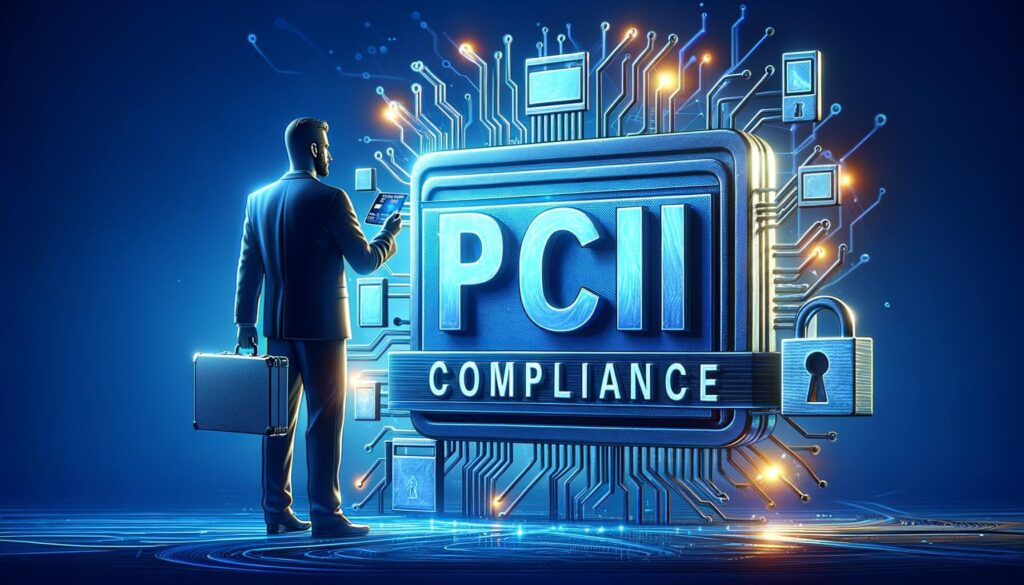
By Catharine Proctor April 2, 2025
In today’s digital age, the security of sensitive customer information is of utmost importance for businesses. With the increasing number of data breaches and cyber attacks, organizations need to take proactive measures to protect their customers’ payment card data. One such measure is achieving Payment Card Industry Data Security Standard (PCI DSS) compliance.
In this article, we will delve into the world of PCI DSS compliance, exploring what it is, its importance, and the 12 requirements that businesses must meet to achieve compliance.
What Is PCI Compliance?

PCI compliance refers to the adherence to the Payment Card Industry Data Security Standard (PCI DSS), which is a set of security standards established by major credit card companies, including Visa, Mastercard, American Express, and Discover. The purpose of PCI DSS is to ensure the secure handling, processing, and storage of payment card data to protect both businesses and consumers from data breaches and fraud.
The PCI DSS compliance requirements apply to any organization that accepts, processes, stores, or transmits payment card data. This includes merchants, service providers, and any other entity involved in payment card transactions. Achieving and maintaining PCI compliance is not only a best practice but also a mandatory requirement for businesses that handle payment card data.
12 Requirements of PCI DSS Compliance

To achieve PCI DSS compliance, businesses must meet a set of 12 requirements outlined by the PCI Security Standards Council. These requirements are designed to address various aspects of data security and provide a comprehensive framework for protecting payment card data. Let’s explore each of these requirements in detail:
1. Install and maintain a firewall configuration to protect cardholder data: Businesses must have a robust firewall in place to secure their network and prevent unauthorized access to cardholder data. Regular updates and maintenance of the firewall are essential to address emerging threats.
2. Do not use vendor-supplied defaults for system passwords and other security parameters: Default passwords and settings provided by vendors are often known to hackers, making systems vulnerable to attacks. Businesses must change default passwords and configure security parameters to ensure the integrity of their systems.
3. Protect stored cardholder data: Businesses must implement strong encryption and security measures to protect stored cardholder data. This includes encrypting data at rest and in transit, as well as securely deleting any unnecessary data.
4. Encrypt transmission of cardholder data across open, public networks: When transmitting cardholder data over public networks, such as the internet, businesses must use strong encryption methods to prevent interception and unauthorized access.
5. Use and regularly update anti-virus software or programs: Anti-virus software helps detect and remove malicious software that can compromise the security of payment card data. Regular updates and scans are crucial to ensure the effectiveness of the software.
6. Develop and maintain secure systems and applications: Businesses must implement secure coding practices and regularly update their systems and applications to address vulnerabilities and protect against potential exploits.
7. Restrict access to cardholder data by business need-to-know: Access to cardholder data should be limited to only those individuals who require it to perform their job responsibilities. Businesses must implement access controls and user authentication mechanisms to ensure data is only accessible to authorized personnel.
8. Assign a unique ID to each person with computer access: Unique user IDs enable businesses to track and monitor individual user activity, making it easier to identify and address any potential security breaches or unauthorized access.
9. Restrict physical access to cardholder data: Physical security measures, such as access controls, surveillance systems, and visitor logs, should be implemented to prevent unauthorized access to areas where cardholder data is stored or processed.
10. Track and monitor all access to network resources and cardholder data: Businesses must implement logging mechanisms and regularly review logs to detect and respond to any suspicious activity or potential security incidents.
11. Regularly test security systems and processes: Regular security testing, including vulnerability scanning and penetration testing, helps identify weaknesses in systems and processes, allowing businesses to address them before they can be exploited by attackers.
12. Maintain a policy that addresses information security for all personnel: Businesses must have a comprehensive information security policy that outlines the roles and responsibilities of personnel, as well as the procedures and guidelines for handling payment card data securely.
What Happens If You’re Not PCI Compliant?

Failure to achieve and maintain PCI DSS compliance can have severe consequences for businesses. Non-compliant organizations may face fines, penalties, and increased liability in the event of a data breach. Additionally, they may lose the trust and confidence of their customers, leading to reputational damage and potential loss of business.
PCI compliance is not just a one-time requirement; it is an ongoing commitment to data security. Failure to comply can result in increased scrutiny from payment card brands, potential loss of the ability to process payment card transactions, and even legal action.
PCI Compliance Checklist – Achieving PCI DSS Compliance

Achieving PCI DSS compliance requires a systematic approach and adherence to the 12 requirements outlined by the PCI Security Standards Council. Here is a checklist to guide businesses in their journey towards achieving and maintaining PCI compliance:
1. Understand the scope: Determine the scope of your cardholder data environment (CDE) and identify all systems, processes, and personnel that interact with payment card data.
2. Conduct a risk assessment: Identify and assess potential risks and vulnerabilities within your CDE. This includes evaluating physical security, network infrastructure, systems, applications, and personnel.
3. Implement security controls: Implement the necessary security controls to address identified risks and vulnerabilities. This may include firewall configurations, encryption, access controls, and monitoring mechanisms.
4. Develop and document policies and procedures: Create comprehensive policies and procedures that outline how payment card data should be handled, stored, and transmitted securely. Ensure that all personnel are aware of and trained on these policies.
5. Regularly update systems and applications: Keep all systems and applications up to date with the latest security patches and updates. Regularly review and update security configurations to address emerging threats.
6. Conduct regular vulnerability scans: Perform regular vulnerability scans to identify any weaknesses or vulnerabilities in your systems and applications. Address any identified issues promptly.
7. Perform penetration testing: Conduct periodic penetration testing to simulate real-world attacks and identify potential security gaps. Address any vulnerabilities or weaknesses discovered during testing.
8. Monitor and review logs: Implement logging mechanisms and regularly review logs to detect and respond to any suspicious activity or potential security incidents. Establish incident response procedures to address any breaches or incidents promptly.
9. Train and educate personnel: Provide regular training and education to all personnel who handle payment card data. Ensure they are aware of security best practices, policies, and procedures.
10. Engage a Qualified Security Assessor (QSA): Consider engaging a QSA to conduct an independent assessment of your organization’s compliance with PCI DSS. A QSA can provide valuable insights and guidance to help you achieve and maintain compliance.
11. Complete and submit the Self-Assessment Questionnaire (SAQ): Depending on the level of your organization’s cardholder transactions, you may be required to complete and submit an SAQ to demonstrate compliance. Ensure accurate and thorough completion of the SAQ.
12. Engage a Payment Application Qualified Security Assessor (PA-QSA): If your organization develops or sells payment applications, consider engaging a PA-QSA to assess the security of your applications and ensure compliance with PCI DSS.
FAQs
Q1. What is the purpose of PCI DSS compliance?
A1. The purpose of PCI DSS compliance is to ensure the secure handling, processing, and storage of payment card data to protect both businesses and consumers from data breaches and fraud.
Q2. Who needs to achieve PCI DSS compliance?
A2. Any organization that accepts, processes, stores, or transmits payment card data needs to achieve PCI DSS compliance. This includes merchants, service providers, and any other entity involved in payment card transactions.
Q3. What are the consequences of non-compliance with PCI DSS?
A3. Non-compliant organizations may face fines, penalties, increased liability in the event of a data breach, loss of customer trust, reputational damage, and potential loss of business.
Q4. Is PCI compliance a one-time requirement?
A4. No, PCI compliance is an ongoing commitment to data security. It requires regular monitoring, updates, and assessments to ensure continued compliance.
Q5. What is a Qualified Security Assessor (QSA)?
A5. A Qualified Security Assessor (QSA) is an individual or organization certified by the PCI Security Standards Council to assess an organization’s compliance with PCI DSS.
Conclusion
In conclusion, achieving and maintaining PCI DSS compliance is crucial for businesses that handle payment card data. By adhering to the 12 requirements outlined by the PCI Security Standards Council, organizations can ensure the secure handling, processing, and storage of payment card data, protecting both themselves and their customers from data breaches and fraud.
PCI compliance is not a one-time task but an ongoing commitment to data security. It requires a comprehensive approach, including implementing security controls, developing policies and procedures, regularly updating systems, conducting vulnerability scans and penetration testing, monitoring and reviewing logs, and training personnel.
Failure to achieve and maintain PCI DSS compliance can have severe consequences, including fines, penalties, increased liability, loss of customer trust, and reputational damage. By prioritizing PCI compliance and following the necessary steps, businesses can safeguard their customers’ payment card data and maintain a secure environment for financial transactions.